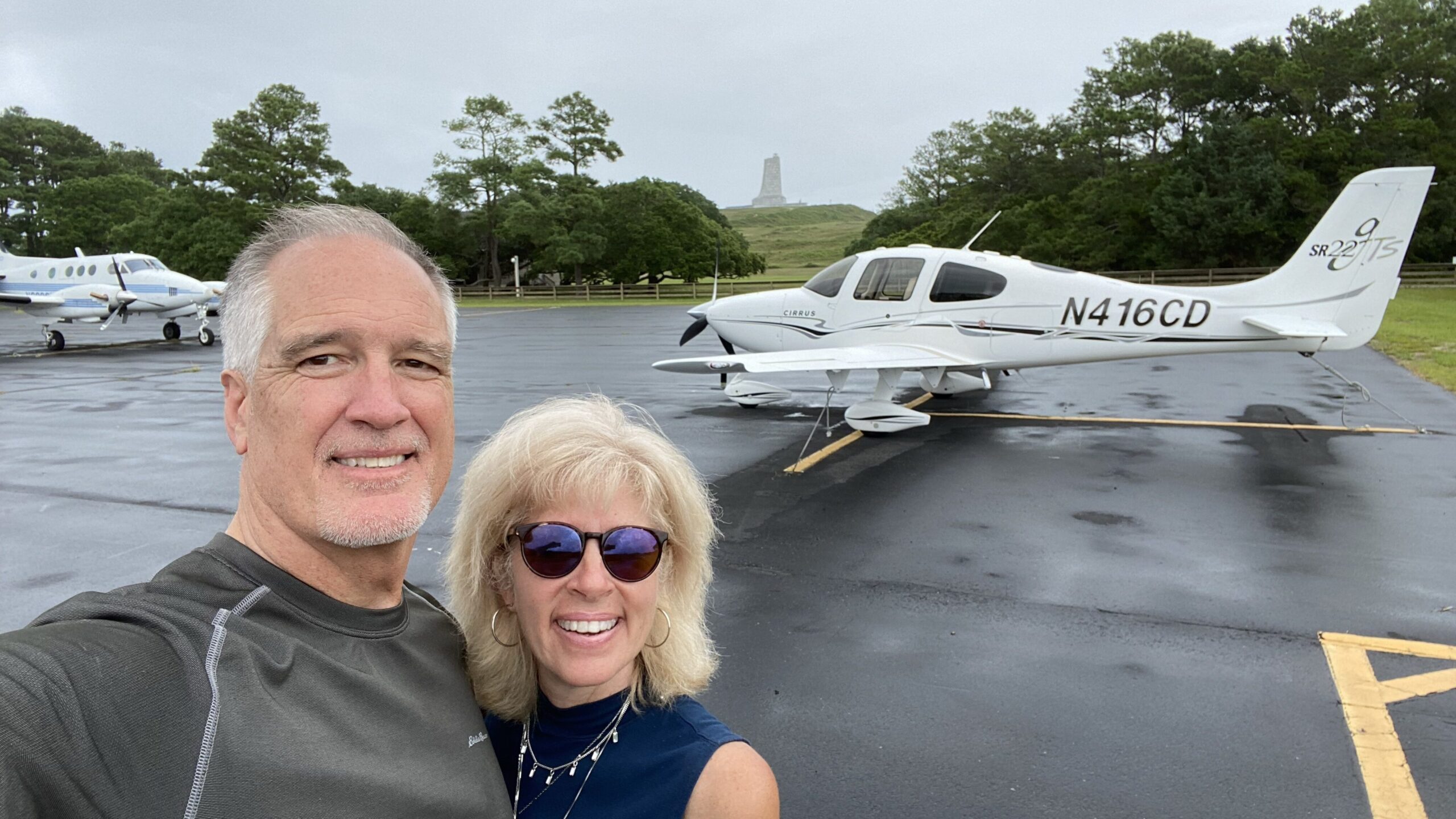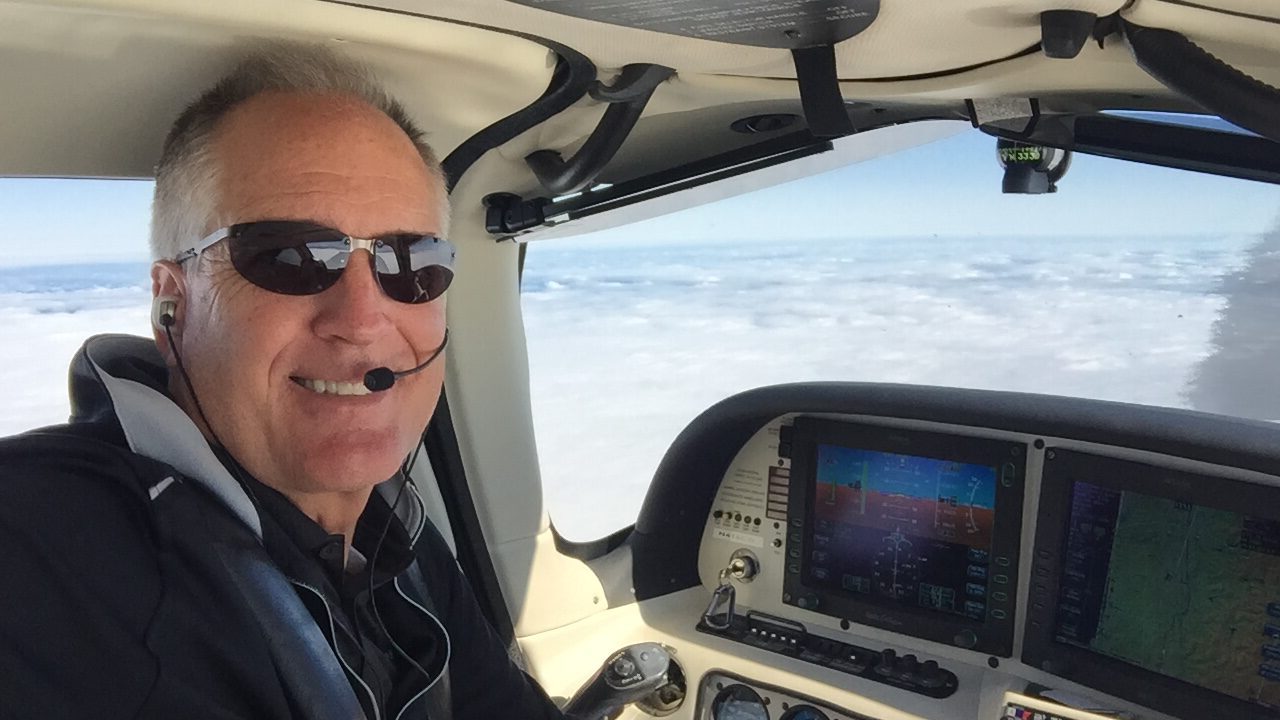Catch Jim Lewis (’96) at his desk, and he is providing operational consulting to corporations, entrepreneurs and high net-worth individuals. As a senior managing director at Mente Group, he draws on management savvy he began building at Embry-Riddle by earning a master’s degree in Aeronautical Science.
Catch him in his Cirrus SR22, and he is changing the lives of veterans and young people with special needs as a volunteer with Veterans Airlift Command (VAC) and Challenge Air. He flies his own aircraft at his own expense on these special missions from his home base in Portland, Oregon. Some fixed base operators underwrite the fuel or provide a discount for public benefit aviation.
VAC is a national network of volunteer aircraft owners and pilots that fills in where the Veterans Administration cannot, providing free air transportation to combat veterans and their families. Lewis started flying with the organization almost 17 years ago when he worked as a sales director at Gulfstream Aerospace Company. He went on to work for Embraer as a sales director and moved to Mente Group in 2016. His job descriptions have varied, but his commitment to sharing the experience of flight has proved to be a constant.
His volunteerism started when he spotted a mention of Veterans Airlift Command in a copy of COPA Magazine, published for the Cirrus Owners and Pilots Association. He loves his Cirrus. “I’ve had it since the day it was built. It is a four-seat, low-wing plane that is remarkably pleasant, powerful, stable, quiet and solid.”
A Noble Use of an Airplane
When Lewis began volunteering with VAC, we were still at war. “I thought there’s a more noble use of the airplane than flying out for $100 pancakes with my buddies on the weekend,” Lewis says. “On one of my first missions, I’m sitting next to a guy missing a leg and fingers, who can’t see out of one eye. He was upset that I was taking him to Sun Valley to learn to ski on a single ski because he felt he should be back in-country, helping his buddies.”
Lewis assured the veteran, “You paid at the office.” He never forgot that encounter. “Giving something back — getting people to a family reunion or vacation — is tremendously rewarding. It reminds you of why you have an airplane.”
The organization puts out group requests to pilots and a description of the passengers and their needs. Lewis volunteers for flights suited to his single-engine aircraft. Most missions he flies are along the Cascade Range.
“Giving something back — getting people to a family reunion or vacation — is tremendously rewarding. It reminds you of why you have an airplane.”
— Jim Lewis (’96)
“Icing conditions are a factor about six months of the year in the Northwest,” he says. “You can’t get far without crossing a mountain range, and minimum enroute altitudes are often above the icing levels. Safety concerns limit which missions I can do.”
Flying severely injured veterans, Lewis never asks but is always willing to listen to the stories of those who want to talk. Often, wives and service dogs ride along. “My job is to give them all a beautiful, smooth ride,” he says. “No bumps. No worries.”
He assures his passengers that the airplane can make some sudden noise, such as the ground proximity warning signal and traffic warnings. He also explains that the plane is equipped with a rocket and parachute in the back.
Born to the Roar of Engines
Lewis’ ties to the military are familial. He was born on an Air Force base in Portugal in the Azores where his father commanded a wing of C-119s and C-124s.

“My dad was, by any definition, the best pilot on the planet,” Lewis says. “He went into the 89th Aerial Port Squadron, and the best of the best are selected for Special Air Missions. He was the chief pilot of the SAM Squadron.”
Despite the high-flying pedigree on his father’s side, Lewis says his mother was the biggest supporter of his interest in aviation.
Giving Co-Pilots a Sense of Control
Lewis has also been a Fly Day volunteer for more than 15 years with Challenge Air.
Former Navy pilot Rick Amber started the nonprofit in 1993. A jet crash left Amber a paraplegic, so he understands how important it is to challenge perceived limitations. He now works with a network of 3,500 volunteers to give young people age 7 to 21 a boost in confidence and self-esteem through flight.
Most Challenge Air events that Lewis attends are held in Independence, Salem or Aurora, around Portland. At a typical Fly Day event, Lewis shares “ground school” basics and a briefing in a hangar talk. Then the co-pilots walk a red carpet to his plane for a 20-30-minute flight.
The highlight of the experience is a turn at the controls.
“I fly with kids who have little control over their arms or legs or thoughts, but in my airplane, I give them a sense of control. That comes with some risk that I have to mitigate, but I like showing them the feedback that comes from their input. It’s direct, immediate and predictable.”
An airplane discovery flight is a little like equine therapy, according to Lewis. “Kids learn to feel in control of something large and powerful, he says.
Parents seated in the back are often more nervous than their child but the beautiful scenery of Oregon’s Willamette Valley is a pleasant distraction. “There are mountains and volcanoes, and they will look down and find themselves enjoying the flight.
Life Changes Course
Lewis originally planned to be an engineer. “I lacked the work ethic, and hated the math,” he says. “All I wanted to do is fly.”
After earning a natural science degree from Florida Southern College, he flew as a commuter and regional airline captain through the 1980s. He still has happy memories of logging more than 3,000 hours in a Beechcraft Starship. Working from Las Vegas, he decided a graduate degree from Embry-Riddle Worldwide was a smart career move.
“They would send you videotapes, and you would be looking over the heads of the students in the classroom,” he says. “As I was flying around for my job, I would hit the pilot lounge, plug in the VCR and watch my sessions. I still have textbooks on my shelf.”

Despite a demanding schedule, Lewis makes time for recreational flying. “On Saturdays, I may fly around with my ‘airport bums,’ many from the Greatest Generation,” he says. “Three years ago, my wife and I visited the Air Force Museum and First Flight. I landed in Kitty Hawk — had to do that. Then we flew to Orlando, where I originally learned to fly, and on to St. Pete and up to New Orleans. We flew 5,800 miles in 11 days.”
It was an Embry-Riddle class that lifted Lewis beyond his own perceived limitations and still benefits him today.
“I remember Dr. Hank Lehrer saying, ‘You will eat, breathe and sleep statistics. Your thesis will consume you for the rest of your life.’ And I thought, ‘No way. I just want to get this done.’ But sure enough, I can be sitting at a stop light and I’ll think ‘It would be a great study if you could …’”
He doesn’t mind the occasional statistical distractions. “I would do it all over again just the way I did it. Every day, I benefit from the stuff I learned at Embry-Riddle.” And because he does, veterans and young people with special needs benefit too.
